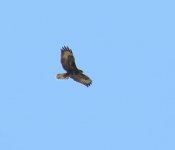JTweedie
Well-known member
I am fairly new to birdwatching but I do go to Baron haugh fairly regularly. However I think i must walk about with my eyes shut as I never seem to see anything like you guys do. Is there any particular part of Barons haugh that is good for seeing a variety of birds.
I tend to come from the car park, visit the 3 hides, then walk along the side of the Clyde for about a mile or 2 where there is another fairly large water area. This is where I normally get a better variety of birds eg ring plover
Any help for a novice would be appreciated. I tend to go mid afternoon maybe this is not the best time
Stewart
I tend to start my walks at the car park, walk down the field and take a left to the first hide. In summer you're pretty much guaranteed sightings of willow warblers from the path directly outside this hide, especially along the clearing where the power cables run. When I leave this hide, I take a left, retracing my path slightly to visit the next hide. The hill and fields to the right along this part of the path are really good for buzzards and kestrels.
After visiting the second hide, I take a left again and head towards the next hide. The short stretch of woodland that you go through can be really good for birds, but you need to have luck as well as hope there's not many other people about making noise. I had three roe deer cross my path here on my last visit a few weeks back.
From the third hide, I take a left again and make my way around to the last hide. The path between these two hides is really good for warblers - during the peak of summer you'll have blackcaps, sedge warblers, willow warblers and chiffchaffs, although some are hard to see because they'll be deep in the undergrowth.
It's always worth keeping an eye out on the river along this path, from the third hide right along the whole length because this is where sand martins nest (you can see them flying in and out of their nests on the bank on the opposite side of the river). Common sandpipers can be seen here too if you're lucky. Towards the end of the path where you before you come to the gate is good for bullfinches, and one summer I sat on the bank with hundreds of sand and house martins and swallows skimming a few feet above my head.
The path along the river is great for butterflies too, especially on a bright sunny day.
I like to go right along to the very end of the path so that I can see the pools of water - these are usually good for geese and waders. I usually just look from the mound rather than go closer to the water - don't want to disturb the birds plus there's usually cattle around.
I then make my way back onto the path and head steeply uphill through conifers. This leads onto the paths that take you into the centre of Dalzell Country Park, and around the big house you can see nuthatches and other woodland birds. Being a mature woodland, it takes patience and luck to see most of the birds here. I think one of the best things you can do is learn the birds' calls so you can identify them by sound first - this could help you spot them. From the big house, it's only a short walk back to the car park where I started the walk.
There are lots of paths branching off along narrow ravines and beside the Japanese garden, so there's so much to explore and it does pay dividends to take your time.
The four hides give a slightly different view of the Haugh, so spending some time in each is worthwhile. I find the best hides are the first two - most of the waders that turn up are visible from these, they tend to hang out on the opposite bank from these hides.
The third hide is good for getting a full view along the length of the reserve, it gives a good "big picture" of the reserve. The last hide I always find to be quieter than the other three and sometimes you can see more secretive birds in the little ponds just in front of it.
Just to add as you mentioned time of day, I've always preferred to go birding in the morning, often the reserves have fewer visitors and some of the birds will be more active. But of course you can see birds most hours of the day especially in summer when the days are longer, and warm light summer evenings can bring out lots of bats and insects.
Last edited:







